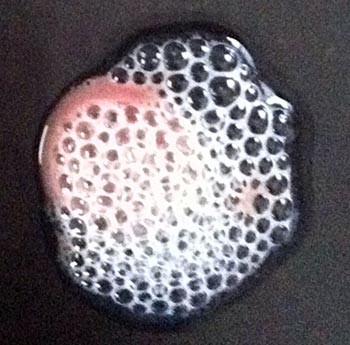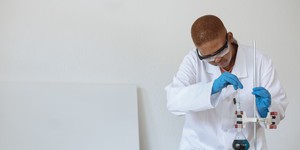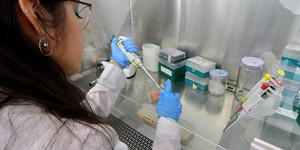Abstract
Sometimes science can be really messy or use pretty disgusting ingredients. That is what it takes to understand how the world works, even if the experiment isn't pretty. Do you like chemical reactions that stink and ooze foamy bubbles? Do you think it sounds fun to make a super gross liver smoothie? Then this is the experiment for you!Summary
Sara Agee, Ph.D., Science Buddies

Objective
In this experiment, you will extract the enzyme catalase from fresh (or frozen) liver, use it to break down hydrogen peroxide, and test the activity of catalase under different conditions.
Introduction
A chemical reaction is when chemicals come together and their molecules interact to form new chemicals. Sometimes chemical reactions happen by themselves. These reactions are usually very fast and spontaneous, and give off energy. Other chemical reactions need energy to happen, and without energy proceed very slowly or not at all.
These types of chemical reactions can be helped to occur more quickly by using enzymes. Enzymes are made out of protein and they speed up the rate of a chemical reaction by acting as a catalyst. A catalyst provides the necessary environment for the chemical reaction to occur, which speeds up the reaction. Certain catalysts work for certain kinds of reactions. In other words, each enzyme has a particular type of reaction that it can activate.
Enzymes are proteins, which are molecules that are very large and dynamic. They can be very fussy, and sometimes need to be in certain environments or conditions to work, and the ideal conditions are usually reflective of where the enzyme must normally function in the body. In other words, different tissues are home to different enzymes, and an enzyme should be able to function in the conditions that surround it in the tissue it's supposed to function in. Some enzymes can be damaged under certain conditions, such as heat. A damaged enzyme will no longer work to catalyze a chemical reaction.
One source of enzymes is the liver, which needs to break down many substances in the body. Catalase is one enzyme from liver that breaks down harmful hydrogen peroxide into oxygen gas and water. When this chemical reaction occurs, you can see the oxygen gas bubbles escaping and causing the reaction to foam, as shown in Figure 1 below.
 Image Credit: Teisha Rowland, Science Buddies / Science Buddies
Image Credit: Teisha Rowland, Science Buddies / Science Buddies
Figure 1. When blended liver is exposed to hydrogen peroxide, the catalase enzyme in the liver reacts with the hydrogen peroxide to form oxygen gas, which creates the visible bubbles in this photograph, and water.
In this science fair project, you will use fresh (or frozen) liver as a source of catalase and investigate how the activity of the enzyme can change under certain conditions. What does catalase do? Under which conditions does it work best? Why do we need catalase in our liver?
Terms and Concepts
To do this type of experiment you should know what the following terms mean. Have an adult help you search the internet, or take you to your local library to find out more!
- Chemical reaction
- Enzyme
- Protein
- Liver
- Catalase
- Hydrogen peroxide
- Acid
- Base
Questions
- Why are enzymes important for making chemical reactions happen?
- Keeping in mind the normal temperature of the human body, how hot do you think an enzyme needs to be for it to become damaged and not function?
- Why are bubbles made when catalase reacts with hydrogen peroxide? What are the bubbles made out of?
- Aside from break down harmful substances, what else does the liver do?
Bibliography
- Rader, A. (2005). Basics of Biochemistry: Enzymes. Retrieved December 13, 2005.
- Kids Health: The Nemours Foundation. (n.d.). How the Body Works: Your Liver. Retrieved July 11, 2010.
Find out why you should "Love Your Liver" from the folks at Kids Health:
- Kids Health: The Nemours Foundation. (n.d.). Your Digestive System. Retrieved June 30, 2010.
Learn all about free-radicals, nutrition, antioxidants and the body:
- MadSci Network. (1999, September 27). Where Does Hydrogen Peroxide come from in the Body?. Retrieved July 26, 2010.
- Youngston, Robert. 1994. "The Antioxidant Health Plan." Harper Collins Publishers, U.K.
Materials and Equipment
- Uncooked liver, fresh or frozen (1/4 lb)
- Knife
- Cutting board
- Blender
- Water
- Refrigerator (with freezer compartment)
- Medicine dropper
- Large plate
- Hydrogen peroxide (use a new or recently-purchased bottle for best results.)
- Measuring teaspoon
- Bowls (4)
- Salt
- Microwave safe bowl
- Microwave
- Vinegar
- Baking soda (optional)
Experimental Procedure
-
First you will want to blend the liver. You will be testing the enzyme activity of the blended liver in the following steps.
- On the cutting board, carefully cut about ¼ lb of liver into little pieces, about 1-2 centimeters in size. You may need an adult to help with this.
- Place the cubes of liver into a blender and add an equal volume of water.
- Carefully blend on high speed, pulsing when necessary, until the liver is smooth and no chunks are present. Keep the blended liver in the refrigerator.
-
Test the activity of the blended liver.
- Put one drop of it on the large plate.
- Add one drop of hydrogen peroxide to the blended liver. As shown in Figure 1 above, you should see a lot of bubbles!
- In your lab notebook, you can record this in a data table like Table 1 below. The blended liver you just tested is your "untreated" sample and it will be your positive control. Use a scale of 0-5, with 5 representing the "most bubbling" and 0 representing "no bubbling." Write down any other observations you make in your lab notebook.
| Treatments | Bubble |
| Untreated | 5 |
| No hydrogen peroxide added | 0 |
| Heated | |
| Frozen | |
| Acidic | |
| Basic | |
| Salted |
Table 1. You can record your data in your lab notebook using a table like this one.
-
Now you will take different samples of your blended liver and test how different conditions affect the liver enzyme's activity.
- To test the effect of heat, place one teaspoon of the blended liver in the microwave in a microwave-safe bowl. Heat covered on high for 20 seconds. What did the heated liver look like? Remove a drop-size amount of the heated liver and put it on a clean part of the large plate. Add one drop of hydrogen peroxide to it. How much did it bubble? Record your results in your data table.
- To test the effect of freezing, put one teaspoon of the blended liver in a bowl in the freezer for about one hour. When the sample is completely frozen, remove it from the freezer and thaw the sample before testing it for enzyme activity. On the large plate, test a drop of the treated liver with hydrogen peroxide. How much did it bubble? Record your results in your data table.
- To test the effect of acid, put one teaspoon of the blended liver in a bowl and add one teaspoon of vinegar. Mix well. What does the mixture look like? On the large plate, test a drop of the treated liver with hydrogen peroxide and record your results in your data table.
- To test the effect of a base, put one teaspoon of the blended liver in a bowl and add one teaspoon of baking soda. Mix well. What does the mixture look like? On the large plate, test a drop of the treated liver with hydrogen peroxide and record your results in your data table.
- To test the effect of high salt conditions, put one teaspoon of the blended liver in a bowl and add one teaspoon of table salt. Mix well. What does the mixture look like? On the large plate, test a drop of the treated liver with hydrogen peroxide and record your results in your data table.
- Knowing that the amount of bubbles made reflects how active the catalase enzyme is, which condition, or conditions, does it look like the enzyme works best under? Which condition, or conditions, makes it work the worst? Why do you think this is?
- Try experimenting with any other condition you can imagine! Remember to record all of your results in your data table! When you are all done with your project, make sure that any surface that the raw liver touched has been completely disinfected.
Ask an Expert
Global Connections
The United Nations Sustainable Development Goals (UNSDGs) are a blueprint to achieve a better and more sustainable future for all.
Variations
- How does catalase change activity when different amounts of the enzyme or the hydrogen peroxide are present? The hydrogen peroxide is called the "substrate," and sometimes changing the amount of substrate or enzyme will change how the chemical reaction proceeds. This is called "enzyme kinetics." Conduct your own experiment on enzyme kinetics by changing the amount of blended liver and hydrogen peroxide in your reactions. What did you find out?
- Another enzyme, called papain, digests proteins and can be extracted from pineapple. One protein that is fun to use for the experiment is Jell-o, made out of gelatin. Try a similar type of experiment on the activity of papain.
- The liver contains many enzymes, each important for detoxifying the body. One of the reasons breaking down hydrogen peroxide is important is because if left alone, hydrogen peroxide in the blood can produce free radicals. Free radicals can cause damage to different parts of the body. Test the effect of hydrogen peroxide on different materials around your house, what happens?
Careers
If you like this project, you might enjoy exploring these related careers:
Related Links
- Science Fair Project Guide
- Other Ideas Like This
- Biotechnology Project Ideas
- My Favorites
- Chemistry Safety Guide
- Visualizing Molecules in Three Dimensions









